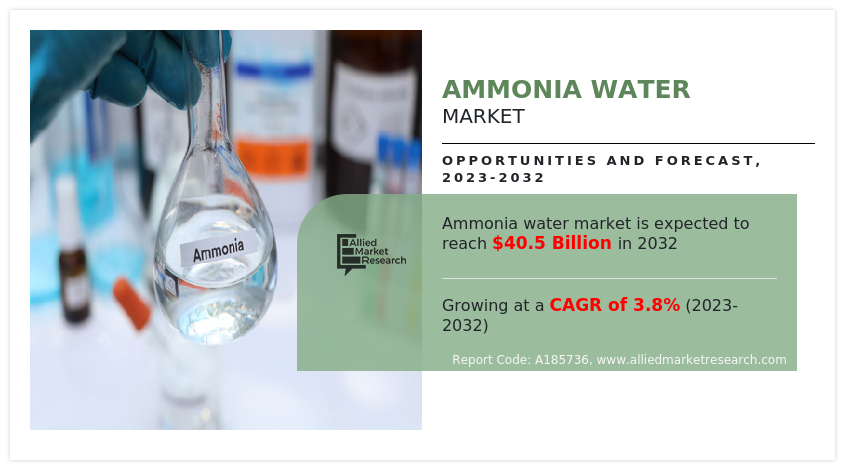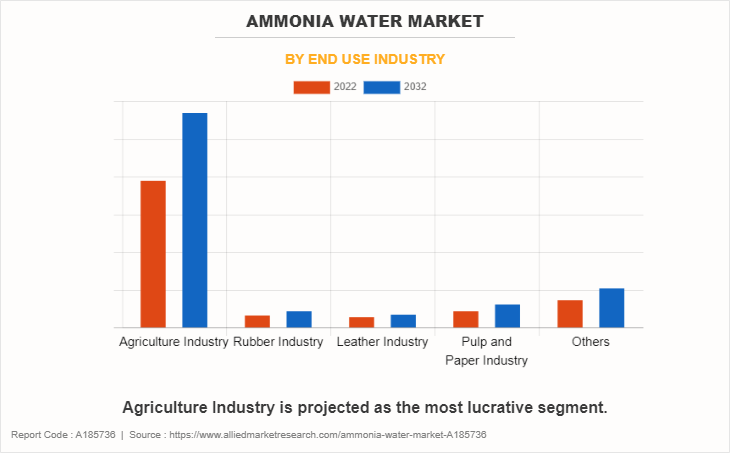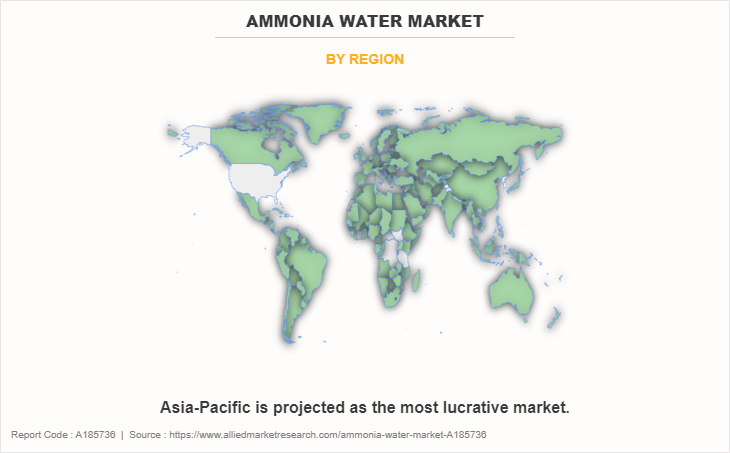Ammonia Water Market Research, 2032
The global ammonia water market size was valued at $28.2 billion in 2022, and is projected to reach $40.5 billion by 2032, growing at a CAGR of 3.8% from 2023 to 2032.
Key Highlighters:
- The Ammonia Water market has been analyzed in value. The value of the ammonia water market is analyzed in millions.
- The global ammonia water market is fragmented in nature with many players such as Evoqua Water Technologies LLC, Veolia, Toray Industries, Inc., General Electric, Koch Separation Solutions, Aquatech International LLC., KUBOTA Corporation, Asahi Kasei Corporation, WEHRLE-WERK AG, and Mitsubishi Chemical Corporation. Also tracked key strategies such as product launches, acquisitions, mergers, expansion etc. of various manufacturers of Ammonia Water.
- Included more than 20 countries in the report which covers market volume as well as market value for all the countries of the ammonia water market.
- Covered the detailed list of manufacturers by application of the ammonia water market. It covers the product information, application, and geographical presence of the companies.
- The qualitative data in this report aims at the battery storage inverters market share, ammonia water market Forecast, ammonia water market Analysis, ammonia water market trends, ammonia water market opportunities, ammonia water market Scope and developments in the industry.

Ammonia water, also known as ammonium hydroxide or aqueous ammonia, is a solution of ammonia gas (NH3) that is dissolved in water (H2O). It is a clear, colorless liquid with a strong, pungent odor. Ammonia water is commonly used in various industrial, commercial, and household applications. Ammonia water is a common ingredient in many household cleaning products, such as glass cleaners, floor cleaners, and multipurpose cleaners. It helps dissolve dirt, grease, and grime. In addition, ammonia water is used in certain pharmaceutical manufacturing processes, such as producing certain types of drugs and medications. In laboratories, ammonia water is used as a reagent in various chemical reactions and experiments.
The growth of the ammonia water market is attributed to several factors. Ammonia water is commonly used in agriculture as a source of nitrogen for plants. As the global population increases and food production needs rise, an increase in demand for fertilizers and agricultural chemicals, including ammonia-based products is expected. Furthermore, ammonia water has various industrial applications, including its use as a refrigerant in certain refrigeration systems and in chemical processes. Growth in industries such as food processing, pharmaceuticals, and chemicals is expected to contribute to increase in demand for ammonia water.
In addition, the need for effective water treatment and wastewater management is growing due to increasing environmental concerns and stricter regulations. Ammonia water is used in water treatment processes to adjust pH levels and control contaminants, which is expected to drive its demand.
Lucrative use of ammonia water in various end-use industries
Ammonia water is used in a wide range of end-use industries for many purposes due to its chemical properties, which is expected to drive the market growth during the forecast period. It is employed in chemicals, electronics and electricals, rubber and plastic, metal, textiles, food and beverage, pharmaceuticals, and other industries. In the rubber and plastic industry, ammonia water is used in rubber vulcanization, which is a major step in enhancing the mechanical characteristics of rubber products.
Ammonia water accelerates the vulcanization process by promoting the cross-linking of polymer chains in rubber compounds, which improves the rubber's flexibility, sturdiness, and resistance to temperature changes. In the plastics industry, ammonia water can be used as a surface treatment and cleaning solution to help remove contaminants and impurities from plastic surfaces prior to further processing. Its alkaline nature enables it to dissolve residues, improving the adherence of applied materials such as coatings and adhesives to plastic surfaces.
In the pharmaceutical sector, ammonia water is used in adjusting the pH of pharmaceutical formulations. The stability, solubility, and efficacy of medications, which have a significant impact on its therapeutic benefits, must be maintained at the ideal pH. The pH-adjusting capabilities of ammonia water are especially beneficial when liquid pharmaceuticals are being produced, as exact pH levels are necessary to maintain the chemical integrity of active components.
In addition, ammonia water is used as a reagent in several analytical procedures and pharmaceutical synthesis processes, that allows in the synthesis and evaluation of medicinal substances. Its controlled application in these conditions assists in the development of effective and safe drugs. Many manufacturers provide ammonia water for use in the pharmaceutical sectors. For instance, Mysore Ammonia Pvt. Ltd. offers ammonia water, which is used in the development of APIs (active pharmaceutical ingredients) and drugs that stop the bacteria from growing and multiplying, in addition to several other uses in pharmaceutical manufacturing and as a neutralizing agent.
In the textile industry, ammonia water plays a significant role due to its versatile chemical properties. One of its main applications is in the printing and dyeing processes. Ammonia water acts as an alkaline agent, facilitating in the fixation of dyes onto materials and modifying color tones. By strengthening the link between dye molecules and the textile fibers during dyeing, it helps to produce vivid and durable colors. This ensures that the colors stay vibrant even after multiple washings. The pH levels of dye baths can also be altered with ammonia water, which enhances the conditions for dye uptake and fixing. This expertise is beneficial when working with natural textiles such as cotton, silk, and wool. Owing to these factors, the extensive utilization of ammonia water in various end-use industries is expected to increase the demand for ammonia water significantly during the forecast period.
The ammonia water market is segmented into end-use industry and region. By end-use industry, it is categorized into the agriculture industry, rubber industry, leather industry, pharmaceutical industry, pulp and paper industry, and others. Region-wise, the market is analyzed across North America, Europe, Asia-Pacific, and LAMEA.
The major players operating in the industry include Evoqua Water Technologies LLC, Veolia, TORAY INDUSTRIES, INC., General Electric, Koch Separation Solutions, Aquatech International LLC., KUBOTA Corporation, Asahi Kasei Corporation, WEHRLE-WERK AG, and Mitsubishi Chemical Corporation. These players have adopted product launch as their key strategy to strengthen their presence in the market.

Based on the end-use industry, the agriculture industry segment dominated the largest market share in 2022 due to ammonia water is a crucial component in the production of ammonium-based fertilizers, such as ammonium nitrate and ammonium phosphate. These fertilizers provide essential nitrogen and phosphorous nutrients to plants, promoting healthy growth and higher yields.

Based on region, the Asia-Pacific region dominated the highest market share in 2022 due to the Asia-Pacific region has strong horticulture and floriculture industry, including the production of fruits, vegetables, and ornamental plants. These sectors often require specialized fertilization techniques, and ammonia water can be a valuable component in meeting their nutrient needs.
Key Benefits For Stakeholders
- This report provides a quantitative analysis of the market segments, current trends, estimations, and dynamics of the ammonia water market analysis from 2022 to 2032 to identify the prevailing ammonia water market opportunities.
- The market research is offered along with information related to key drivers, restraints, and opportunities.
- Porter's five forces analysis highlights the potency of buyers and suppliers to enable stakeholders make profit-oriented business decisions and strengthen their supplier-buyer network.
- In-depth analysis of the ammonia water market segmentation assists to determine the prevailing market opportunities.
- Major countries in each region are mapped according to their revenue contribution to the global market.
- Market player positioning facilitates benchmarking and provides a clear understanding of the present position of the market players.
- The report includes the analysis of the regional as well as global ammonia water market trends, key players, market segments, application areas, and market growth strategies.
Ammonia Water Market Report Highlights
| Aspects | Details |
| Market Size By 2032 | USD 40.5 billion |
| Growth Rate | CAGR of 3.8% |
| Forecast period | 2022 - 2032 |
| Report Pages | 190 |
| By End Use Industry |
|
| By Region |
|
| Key Market Players | Sumitomo Chemical Co., Ltd., Yara, Jaysons Chemical Industries, Thatcher Company, Mysore Ammonia Pvt. Ltd., BASF SE, Shandong Everlast AC Chemical Co., Ltd., Malanadu Ammonia Pvt. Ltd., Mitsubishi Chemical Group Corporation, CF Industries Holdings, Inc. |
Analyst Review
As per the insights of the top-level CXOs, the growing demand for ammonia water in industrial sectors such as refrigeration, chemicals, and manufacturing, is driven by factors such as urbanization, industrialization, and technological advancements. Furthermore, shift toward more environmentally friendly solutions, with ammonia water being recognized for its relatively lower environmental impact as compared to some alternatives. Moreover, ongoing R&D efforts to find new applications and formulations for ammonia water are expected to lead to expanded markets and increased adoption in various industries.
However, ammonia emissions can contribute to air pollution and have environmental implications. Concerns over its impact on air quality and ecosystem health are expected to lead to stricter regulations or reduced demand.
Ammonia water can be used in wastewater treatment facilities to help control pH levels and remove certain contaminants through processes like chlorination. This factor will drive the market growth during the forecast period.
Agricultural industry is the leading end-use industry of Ammonia Water Market.
Asia-Pacific is the largest regional market for Ammonia Water.
The Ammonia Water Market was valued for $28.2 billion in 2022 and is estimated to reach $40.5 billion by 2032, exhibiting a CAGR of 3.8% from 2023 to 2032.
The major players operating in the industry include Evoqua Water Technologies LLC, Veolia, TORAY INDUSTRIES, INC., General Electric, Koch Separation Solutions, Aquatech International LLC., KUBOTA Corporation, Asahi Kasei Corporation, WEHRLE-WERK AG, and Mitsubishi Chemical Corporation.
Loading Table Of Content...
Loading Research Methodology...



